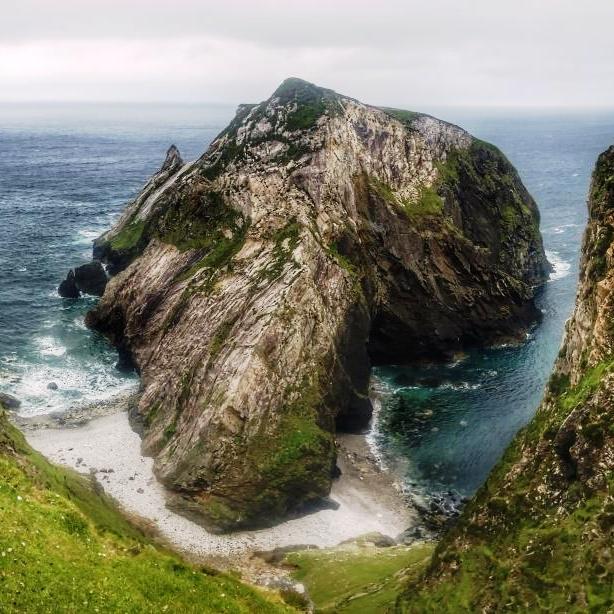Living of the northern outer edge of the hinterland that is the Slievetooey Massif in south west Donegal, Gull Island is 95 metres high and is joined to mainland Donegal by a raised shingle beach bar. Gull Island is a huge flat-topped sea stack sitting in the middle of a huge expanse of lonely, remote and uninhabited coastline. Stretching 5km to Maghera the East and 12km to the south West of this stack is a wall of outrageous 300m sea cliffs, which effectively guard this coastline from any sane visitor.
Easiest access is by an excellent walk over the Slievetooey summit from the south and descending its northern slopes to a lonely, remote and outstanding location on the clifftops overlooking Gull Island. The descent to the boulder beach joining Gull Island to the mainland is by steep grass and a little loose rock. There is an abseil stake in place (2009) to safeguard the initial part of the descent. This takes you to a huge raised shingle spit of sea-washed boulders and flotsam joining Gull Island to the mainland of Donegal.

1: Gull Island lives at the base of the north face of the Slievetooey sea cliff, it is one of the most remote places on mainland Ireland.
2: The grassy approach slope is quite steep to the raised shingle storm beach, which has allowed non-nautical access at all tide states.
3: The rock on the stack is good BUT your situation causes everything to appear a wee bit more atmospheric than it actually is.
4: The ropework on the stack requires a wee bit of thought as it is not conventional esp, as always ensure your descent by inspecting and if needed rerigging the abseil belays as you climb the route.
5: 60 metre half ropes are best, as the last abseil is 45m to the ground.
6: The summit is the size of a football field and is a bit of a mindblower.
The summit of Gull Island is a huge expanse of untouched and unspoilt wilderness with several birds of prey, many ground nesters and the odd rabbit/puffin burrow in attendance on this 100 square metre summit.
The summit of Gull Island has been stood on twice, the first ascent in 2009 by Iain miller and Martin Boner and again in 2013 by Iain Miller and Louise O'Connor.
The stack is climbed in three huge pitches up this landward arete. The first pitch could be called the death pitch as it is unprotected for its first 40m but thankfully it presents easy climbing. This takes you to a slabby flattening and a tri-peg belay. (pegs placed in 2009 and re-rigged in 2013) The following 100m of climbing takes you directly up the arete with an excellent mix of big-block scrambling, slabby crimping and jungle bashing in equal measure.
Gull Island E1 5a 125m
This route climbs the outrageous, soaring landward arete of this 100mtr beast. Descent from the summit is by guile and 2 abseils down the route. This route has to be seen to be believed!
Pitch 1, 50m, 3a. To the West of the landward arete climb the huge corner crack until it terminates. Traverse right & ascend the ramp to gain arete & a tri-peg belay. (3 good gear placements in 50m, fall and U will die)
Pitch 2, 25m, Continue up the Arete by a very atmospheric scramble to the big block overhang at the base of the boulder field. (2 Peg Belay placed in 2013)
Pitch 3, 50m, Climb the stacked boulder field to the two big boulders on top. Crimp left and ascend up the superb rock, continue to the summit through two rock bands.
I. Miller, M. Boner 24/04/09